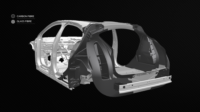PARIS—While most recent electric car activity has focused on high-end, luxury models, engineers at BASF and Citroën are taking a much different approach. They recently developed a small, affordable, lightweight car dubbed oli [all-ë], It uses innovative materials and serves as “a manifesto to how much can be saved by reducing weight and resource usage.”
“The car runs counter to the trend toward increasingly heavier and more complex vehicles, instead focusing on ease and simplicity,” says Laurence Hansen, director of product and strategy at Citroën. “It demonstrates how to keep environmental impact to a minimum, while bringing back the fun of a functional, electric vehicle.”
With speed limited to 68 mph and acceleration close to the classic Citroën 2CV model, the concept car features a minimalistic approach to EV design.
Various components are constructed by using materials in a different context. For example, the complete backrest is made of a flexible 3D-printed plastic material. The open lattice structure provides natural air flow, replacing all ventilators in the seat.
“This concept car shows what can be achieved when partners trust one another and are bold enough to tread new paths,” explains Uta Holzenkamp, president of BASF’s coatings division. “The result is an entire microcosm of ideas and solutions that goes way beyond the original concept.”
Holzenkamp claims that many of the new components are designed and manufactured with materials from the same chemical product family. Traditionally, she says bonded and welded components made from different materials are a challenge in mechanical recycling. That’s why the engineers created as many components as possible from a single material.
This principle of simplicity was also implemented during production. For instance, the driver and front passenger doors are identical, which reduces complexity. The same applies to all wheel arches and bumpers.
The hood, roof and trunk are made of plastic honeycomb sandwich panels that combine BASF’s Elastoflex polyurethane system and Elastocoat spray paint system.
”The oli concept car is proof of the fact that sustainability and an appealing design are not contradictory,” claims Holzenkamp. “The weight of the vehicle exterior was also considerably reduced, while at the same time increasing stability and durability.”



